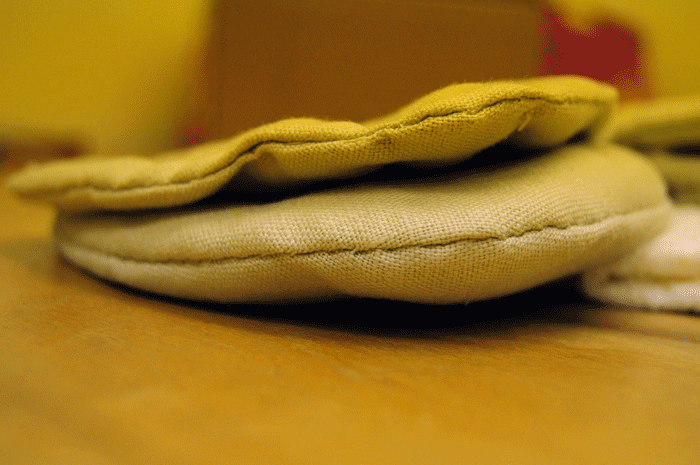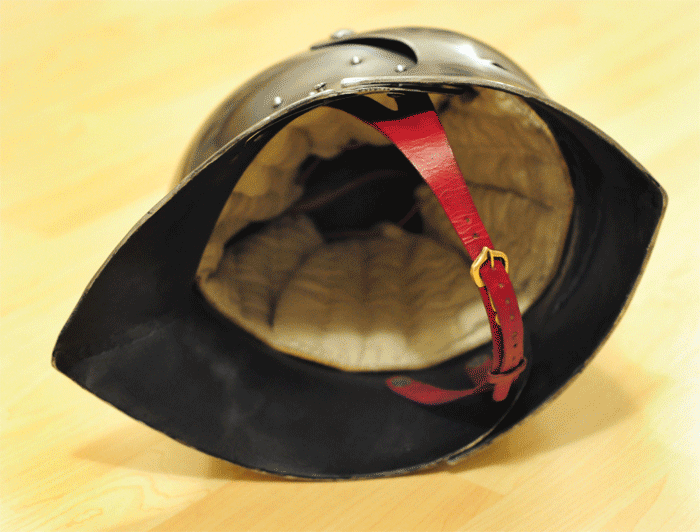Hello,
I would be interested in what you know about the padding under helmets. How thick were they? Does this change through centuries? What was the most common for padding linen or leather? How common was fixing the padding in the helmet? And what are the average diameters of the helmets through centuries?
I have seen many helmets by reenactors and on films but some seem really thin others too thick.
Waiting for your answer.
David
Anyone some informations to share?
This should be about right. I've researched this issue, too, and the recommendation that it be about as thick as a kitchen "hot pad" after quilting seems to work well. It really couldn't be much thicker if the helmet fits properly. The first image below shows the stitched lining on top and the un-stitched lining below. In both cases, I'm using four layers of organic cotton batting.
 Attachment: 144.93 KB
Attachment: 144.93 KB

 Attachment: 159.82 KB
Attachment: 159.82 KB



In the high middle ages at least, the standard padding is a padded linen coif. Thuis can be of a two or three piece construction. In the 12th century, a round topped coif with a thicker "roll" around the head seems to have been popular.
In some of the depictions, the padding seems to be quite thick, but then again these show people going into battle without a rigid helmet.
Early helmets seem to have been quite thin and close fitting, later ones larger and with more padding. This could be seen in relation to armour replacing shields as the primary defence, and the greater numbers of swung weapons in the battle lines. (Early infantry fighting fighting more or less exclusively with shield and spear in the line.
In some of the depictions, the padding seems to be quite thick, but then again these show people going into battle without a rigid helmet.
Early helmets seem to have been quite thin and close fitting, later ones larger and with more padding. This could be seen in relation to armour replacing shields as the primary defence, and the greater numbers of swung weapons in the battle lines. (Early infantry fighting fighting more or less exclusively with shield and spear in the line.
| Sean Flynt wrote: |
| It really couldn't be much thicker if the helmet fits properly. |
Yes but what if they didn't fit properly, for example in the viking age iron was not a cheap thing and so helmets were worn through generations, but could this include that it were a bit oversize(?).
Do you know museum helmet sizes? I guess this could serve a lot.
| David GaŠl wrote: | ||
Yes but what if they didn't fit properly, for example in the viking age iron was not a cheap thing and so helmets were worn through generations, but could this include that it were a bit oversize(?). Do you know museum helmet sizes? I guess this could serve a lot. |
I don't, but they are often smaller in person than they seem in photos, and mass-produced modern reproductions tend to be VERY large.
| Sean Flynt wrote: |
| This should be about right. I've researched this issue, too, and the recommendation that it be about as thick as a kitchen "hot pad" after quilting seems to work well. |
Could you please write it in cm how thick is yours? Would help more imagining it.
Thanks very much for your replay.
~6.35 mm (.635 cm). That corresponds to the figure of .25" I found from a reliable source.
Thank you. I have a linen coif that has almost the same measure so if I make helmets for that size it could be accurate. A bit weird that I am interested for such things for a while and only now have I only the idea of what if its wrong.
But is this thickness enough against a hit by a two handed weapon?
But is this thickness enough against a hit by a two handed weapon?
From what I have seen most helmet liners are linen cloth with raw cotton padding. I based my liners off of these examples which you can see here: http://www.historiclife.com/Armory.htm
Thickness varies a bit but the hot pad description is the average.
Thickness varies a bit but the hot pad description is the average.
| David GaŠl wrote: |
| Thank you. I have a linen coif that has almost the same measure so if I make helmets for that size it could be accurate. A bit weird that I am interested for such things for a while and only now have I only the idea of what if its wrong.
But is this thickness enough against a hit by a two handed weapon? |
It was good enough for guys actually getting hit with swords, maces and halberds. It helps if the liner is a suspension as well as a padded defense.
It makes me wonder how thick padding was underneath something like an armet or close helmet.
I guess in relation to people using "too thick" padding, as pointed out in period padding wasn't what (well, at least I wouldn't) one would call thick, but that's because I assume they'd move around a lot more then people do today.
I've recently made a stuffed liner for a very particular style of helmet, I'll see if I can take pictures of it and post it. I fear it may be over kill a bit.
Edit: Okay, so, I can't get a camera any time soon, so I hope this crude picture will help convey what I mean.
 Attachment: 6.73 KB
Attachment: 6.73 KB
Stuffed. 2cm thickness on average. [ Download ]
 Attachment: 48.66 KB
Attachment: 48.66 KB
For this style. [ Download ]
I guess in relation to people using "too thick" padding, as pointed out in period padding wasn't what (well, at least I wouldn't) one would call thick, but that's because I assume they'd move around a lot more then people do today.
I've recently made a stuffed liner for a very particular style of helmet, I'll see if I can take pictures of it and post it. I fear it may be over kill a bit.
Edit: Okay, so, I can't get a camera any time soon, so I hope this crude picture will help convey what I mean.
Stuffed. 2cm thickness on average. [ Download ]
For this style. [ Download ]
Last edited by Sam Gordon Campbell on Fri 13 Jan, 2012 6:14 pm; edited 1 time in total
Here is the Leiden spangenhelm
http://www.romanarmy.com/cms/component/option...Itemid,96/ If you click Remarks there's a mention of a 6mm thick leather cap that was found inside the helmet. At 188mm deep I'm thinking this helmet must have had a liner besides the cap or the helmet would sit too low.
http://www.romanarmy.com/cms/component/option...Itemid,96/ If you click Remarks there's a mention of a 6mm thick leather cap that was found inside the helmet. At 188mm deep I'm thinking this helmet must have had a liner besides the cap or the helmet would sit too low.
A good idea is to have some space between the liner and the helmet itself, so the the helmet and head are only close together at brow level. Then you wonīt need much padding, any hit will be spread over the head, there is actually not much contact between the hit section of the helmet and the head itself.
| Sam Gordon Campbell wrote: |
| It makes me wonder how thick padding was underneath something like an armet or close helmet. |
I have seen some that could have thicker padding but couldn't say how thick. Siege armours from the 17th century could have thicker padding for example: http://www.antiqueweaponstore.com/Rare%20Germ...th%20C.htm (look at the breastplate)
But I haven't seen yet more thicker than 10mm. I think the average could be as Sean Flynt wrote.
I have seen padding in authentic helmets from 1/4 to near 7/8. I have seen them stuffed with anything from dried plant matter, cotton to what looks like bits of left over fabric. My Average is about 3/8 to 5/8 but depends on if this is a padded liner or a padded coif used with a leather or another liner suspension system.
The Black Sallet at the RA is actually very thick and in rather excellent condition considering its age
http://www.myArmoury.com/talk/viewtopic.php?t=5451
I had several 'siege' helmets from the 17th I took care of with padding and they do seem fairly padded. On had 3/4" of padding even down to the face which must have been rather warm and part of the padding looked to be made of weeds and hay for padding.....
RPM
The Black Sallet at the RA is actually very thick and in rather excellent condition considering its age
http://www.myArmoury.com/talk/viewtopic.php?t=5451
I had several 'siege' helmets from the 17th I took care of with padding and they do seem fairly padded. On had 3/4" of padding even down to the face which must have been rather warm and part of the padding looked to be made of weeds and hay for padding.....
RPM
Page 1 of 1
You cannot post new topics in this forumYou cannot reply to topics in this forum
You cannot edit your posts in this forum
You cannot delete your posts in this forum
You cannot vote in polls in this forum
You cannot attach files in this forum
You can download files in this forum
All contents © Copyright 2003-2006 myArmoury.com — All rights reserved
Discussion forums powered by phpBB © The phpBB Group
Switch to the Full-featured Version of the forum
Discussion forums powered by phpBB © The phpBB Group
Switch to the Full-featured Version of the forum